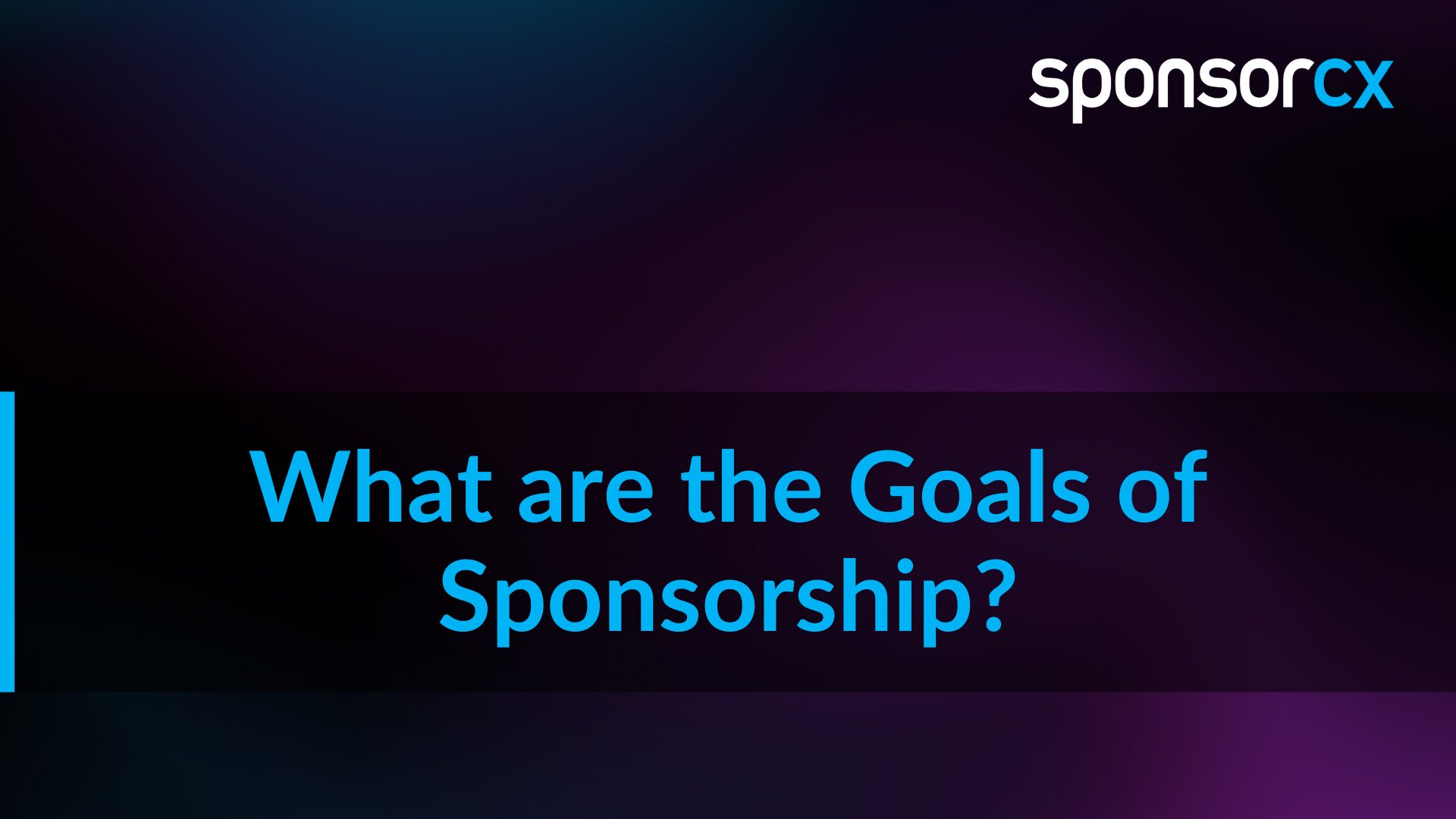What Are the Goals of Sponsorship?
The answer to this question is not as complex as it may sound. The goal of any sponsorship is to generate revenue. Whether you’re a non-profit, a not-for-profit, or a normal for-profit organization, making money makes everything else work. But as the old saying goes, “The devil is in the details.” The ways we go about generating revenue determine our strategic sponsorship goals.
In this article, we’ll discuss goals and tips that will enable you to reach your revenue goals.
Setting Clear Sponsorship Objectives
Clear sponsorship objectives ensure that all activities align with a brand’s strategic priorities. Clear and concise goals enable measurement of sponsorship success and maximize sponsorship benefits. Take Red Bull, for example. Red Bull’s sponsorship of extreme sports events focuses on building brand image and connecting with a young, adventurous target audience. By defining these specific goals, Red Bull tailors its activations to resonate with its target market.
Establishing goals also facilitates better communication with stakeholders and aligns and synergizes your team’s efforts toward achieving the same objectives. Clarity allows for more targeted and impactful sponsorship strategies, driving meaningful results and fostering long-term partnerships. Clear sponsorship goals are vital for realizing the full potential of any sponsorship investment.
Understanding Sponsorship Goals & Objectives
Sponsorship goals and objectives guide a brand’s sponsorship activities and investments. Every organization must consider the following key sponsorship goals.
Increase Brand Awareness
Sponsorship increases brand awareness by putting your brand in front of targeted, engaged audiences. For instance, Emirates’ sponsorship of the Arsenal Football Club helps Emirates reach football fans worldwide. The brand’s reach aligns with its sponsorship goal to enhance global visibility and connect with passionate sports audiences. By including partnerships like Arsenal in its sponsorship portfolio, Emirates builds brand recognition and loyalty.
Enhance Audience Engagement
Audience engagement activities foster direct interaction with potential and existing customers, creating memorable experiences and personal connections. Under Armour’s partnership with NBA star Stephen Curry includes interactive events like basketball clinics and social media challenges. These activities align with Under Armour’s sponsorship goals of deepening customer relationships and enhancing brand loyalty.
Under Armor achieves sponsorship benefits by incorporating audience engagement events into its sponsorship portfolio, including increased customer affinity and brand advocacy. Clear sponsorship objectives strategically focus and drive meaningful and lasting connections with audiences.
Improve Market Position
Sponsorship can position a brand as a leader or innovator in its industry by associating it with cutting-edge events and influential figures. A good example is Intel, whose sponsorship of the International Consumer Electronics Show (CES) showcases its commitment to technological advancement. It supports Intel’s goal of highlighting tech innovation and leadership.
By including CES in its sponsorship portfolio, Intel reaps sponsorship benefits, including enhanced credibility and industry recognition. Clear sponsorship objectives ensure that these efforts strategically promote Intel’s image as a trailblazer and reinforce the company’s market position as a technology leader.
Support Corporate Social Responsibility (CSR)
Sponsorships can support community initiatives and enhance a company’s CSR profile by associating the brand with positive social efforts. Take Tom’s of Maine. Tom’s manufactures natural personal care products. Its sponsorship of local community events and social programs aligns with its sponsorship goals to promote social responsibility and community support.
These activities, part of the brand’s sponsorship portfolio, provide sponsorship benefits such as increased goodwill and strengthened community ties. By setting clear sponsorship objectives focused on CSR, Tom’s boosts its brand image and contributes meaningfully to societal well-being.
Generate Leads
Lead generation is a key sponsorship goal that enables brands to connect with potential customers. Salesforce’s sponsorship of the Dreamforce annual user conference is a good example. Sponsoring the conference aligns with Salesforce’s objective to attract and engage business leaders and decision-makers. This event, part of Salesforce’s sponsorship portfolio, offers significant sponsorship benefits by generating high-quality leads and fostering direct interactions with potential clients.
Clear brand sponsorship objectives guide Salesforce’s efforts, boosting sales and expanding the company’s customer base.
Create Networking Opportunities
Networking opportunities facilitate connections with potential partners and industry leaders. For example, IBM’s sponsorship of the Cannes Lions International Festival of Creativity aligns with its sponsorship objectives. The event provides an opportunity to engage with top creatives and tech innovators and offers significant sponsorship benefits such as fostering relationships, exchanging ideas, and exploring collaborations. Clearly defining sponsorship objectives makes strategic and impactful networking efforts possible.
Managing a Sponsorship Portfolio
Effectively managing a sponsorship portfolio is essential to align a brand’s strategic goals and deliver maximum value. Best practices include:
- Setting clear sponsorship goals and objectives
- Regularly evaluating sponsorships
- Maintaining open communication with partners
General Electric
General Electric (GE) manages a diverse sponsorship portfolio that includes sports, technology, and community events aligned with its brand sponsorship objectives of innovation and community engagement.
- GE’s partnerships in technology showcase its commitment to cutting-edge solutions and leadership in innovation. Partnering with cutting-edge events, such as tech expos or global innovation summits, highlights its leadership in advanced solutions. Sponsoring robotics competitions or clean energy conferences aligns with its focus on sustainability and innovation. This positions the company as a thought leader in industries critical to the future.
- GE aligns with sports organizations emphasizing teamwork, perseverance, and performance to tap into dynamic, wide-reaching platforms that resonate with global audiences. By supporting high-profile teams or events, the company reaches a broad audience while promoting shared values like teamwork and resilience. For instance, a collaboration with a marathon series not only associates the brand with endurance and achievement but also provides opportunities to showcase its health technology solutions.
- GE’s community-focused sponsorships reflect its dedication to fostering meaningful local relationships and social impact. Sponsorships of local initiatives, such as urban renewal projects or STEM education programs, demonstrate the company’s investment in social progress. Funding a community maker space reinforces its focus on education and innovation while fostering a direct connection with residents.
By linking each sponsorship to a broader theme — whether promoting sustainability, advancing technology, or enriching local communities — the company ensures consistency and authenticity in its brand message while maximizing its return on investment.
Here are four basic steps that will help you manage your sponsorship objectives.
Identify Potential Sponsorship Partners
Identifying potential sponsorship partners begins with understanding your brand’s goals, target audience, and core values. Look for organizations or events that align with these facets of your organization. Evaluate the partner’s audience demographics, market reach, and reputation to determine compatibility. Consider whether the partnership can provide shared storytelling, co-branded content, or community engagement opportunities. Analyze their past sponsorships to assess alignment with your objectives. Lastly, ensure the partner’s mission and vision complement your brand’s image, creating a mutually beneficial relationship that strengthens both parties’ visibility and impact.
Define Your Goals
Setting measurable goals with a sponsorship partner begins by defining clear, mutual objectives that align with both parties’ strategic priorities. Identify metrics such as audience engagement, brand awareness, lead generation, or sales impact. Establish key performance indicators (KPIs) like social media impressions, event attendance, or customer acquisition rates. Outline timelines for tracking progress and set benchmarks for evaluating success. Ensure both parties agree on data-sharing methods and reporting formats to maintain transparency. By setting precise, measurable goals, the partnership can focus on delivering tangible outcomes that demonstrate value and strengthen the relationship.
Define How You Add Value
This is what marketers call a “unique selling proposition” (USP). It explains how and what you have to offer to differentiate yourself from competitors. A team or event can add value to a sponsorship partner by providing unique opportunities for brand exposure, audience engagement, and alignment with shared values. Value is created when the partnership connects the sponsor’s goals to meaningful interactions with a targeted audience, delivering measurable results. For example:
- The Boston Marathon adds value to its sponsors through extensive global reach and strong brand alignment. John Hancock, its long-time sponsor, leverages the marathon to showcase its commitment to health, wellness, and community engagement. The event provides branding opportunities across race materials, digital platforms, and broadcast coverage, reaching millions of viewers worldwide.
- John Hancock further maximized the partnership by launching the John Hancock Marathon Nonprofit Program, which ties the race’s charitable mission to its brand. By offering race entries to nonprofits, the program raised over $13 million annually for various causes, reinforcing John Hancock’s focus on social responsibility. This initiative enhanced brand perception and deepened community connections.
- Additionally, the Boston Marathon provides hospitality opportunities where John Hancock engages clients and employees through exclusive experiences, such as hosting VIP guests at viewing areas and offering behind-the-scenes tours. This integration of brand values, audience reach, and meaningful engagement demonstrates how a well-executed sponsorship can deliver value beyond traditional advertising.
By offering platforms for storytelling, audience interaction, and shared purpose, teams and events can create partnerships beyond visibility, fostering authentic connections and delivering ROI for their sponsors.
Nurture Relationships With Your Sponsorship Partners
Maintaining strong relationships with sponsorship partners requires clear communication, mutual respect, and consistent value delivery.
- Purpose and Goal Alignment. Begin by aligning on the purpose of sponsorships and ensuring both parties are focused on common goals of sponsorships. Regular check-ins help track progress toward sponsorship objectives and address any challenges.
- Provide Measurable Results. Show how the partnership is achieving its goals. Tailored reporting, such as metrics from sports sponsorships, engenders transparency and trust. Recognize your partner’s contributions through public acknowledgments or co-branded campaigns to strengthen the relationship.
- Flexibility. Flexibility is key. Be open to adapting activations to meet evolving needs.
- Nurture Personal Connections. Bolster your relationships beyond contract terms by fostering personal connections. Create networking events and collaborate on plans. A strong partnership is built on mutual benefits, clear objectives, and ongoing engagement, ensuring long-term success for both parties.
How to Measure Sponsorship Success
You should measure several key metrics to help you track your sponsorship goals and objectives. These include many of the goals we’ve discussed, plus a few more.
- Brand Awareness. Because visibility can significantly impact consumer perception, increasing brand awareness is a common objective in sponsorships, especially sports sponsorships.
- Audience Engagement. Increasing audience engagement is a cornerstone in measuring sponsorship success because it fosters meaningful connections and amplifies brand impact.
- Lead Generation. Generating leads reflects the alignment of sponsorship objectives with the purpose of sponsorship, which is to drive actionable business outcomes.
- ROI. ROI measures how effectively the sponsorship objectives are met and ensures the investment aligns with the overall purpose of sponsorships to deliver tangible value.
- Media Exposure. Increasing media exposure supports the sponsorship objectives of enhancing brand visibility and fulfilling the purpose of sponsorships to reach wider audiences.
- Sales Impact. Increased sales demonstrate how well the sponsorship objectives drive revenue and business growth.
- Customer Feedback. Positive customer feedback is essential to sponsorship success because it builds brand trust and strengthens customer relationships.
- Website Traffic. An uptick in web traffic demonstrates success in expanding digital reach.
- Activation Success. Successful activations demonstrate how well the sponsorship objectives translate into meaningful audience engagement by creating impactful connections.
Tools like Google Analytics, social media analytics, and customer surveys can track performance.
- Google Analytics can measure web traffic and conversions driven by sponsorships.
- Social media analytics can assess engagement and reach.
- Customer surveys provide direct feedback on brand perception and the effectiveness of activations.
Pre- and post-event analysis will provide insights into your sponsorships’ performance. A regular review of key metrics will identify areas for improvement. Ongoing measurement and evaluation empower you to make informed decisions that enhance the value and impact of your sponsorship portfolio.
Benefits of Using SponsorCX
SponsorCX can help streamline the goal-setting process. It will empower you to align sponsorship goals and objectives with overall brand objectives. Its sponsorship management platform provides tools to track performance, measure ROI, and optimize sponsorship benefits.
With SponsorCX as your partner, you can optimize efforts to meet your sponsorship goals and take the guess work out of decision-making. SponsorCX will help you maximize the value of your sponsorship.
The Bottom Line
Setting clear sponsorship goals and objectives will help you get the most from your sponsorship portfolio. By aligning sponsorships with your brand objectives, tracking performance, and leveraging tools like SponsorCX, you can optimize sponsorship benefits and achieve impactful, strategic outcomes for your brand.











